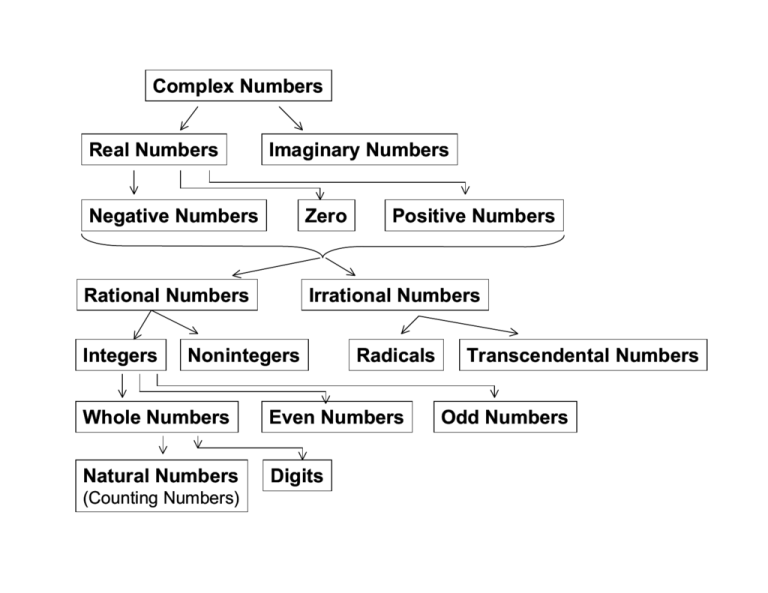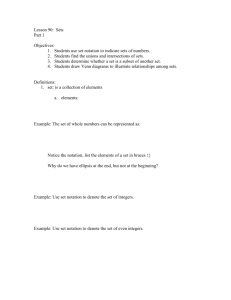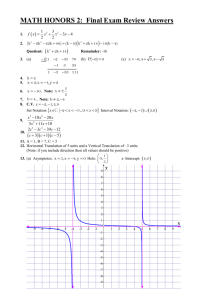Complex Numbers Real Numbers Imaginary Numbers Negative
advertisement

Complex Numbers
Real Numbers
Imaginary Numbers
Negative Numbers
Zero
Rational Numbers
Irrational Numbers
Integers
Nonintegers
Positive Numbers
Radicals
Whole Numbers
Even Numbers
Natural Numbers
Digits
(Counting Numbers)
Transcendental Numbers
Odd Numbers
A set is any well-defined list or collection of objects, and will be
denoted by capital letters A, B, C, … , Z.
R = {Reals}
N = {Natural Numbers}
S = {a, b, c}
The objects comprising the set are called its elements or members
and will be denoted by lowercase letters a, b, c, … , z.
The statement “p is an element of A” or, equivalently “p belongs to A”
is written p ∈ A.
The negation of p ∈ A is p ∉ A.
Two sets A and B are equal if they have exactly the same members,
and will be denoted by A = B.
A ≠ B means the elements of set A and set B are not all exactly the
same.
There are essentially three ways to specify a particular set.
One way, if it is possible, is to list its members in braces, { and },
and separate each item with a comma. This is the roster notation.
Words
Roster Notation
The vowels in the English alphabet.
V = {a, e, i, o, u}
The Digits.
D = {0, 1, 2, 3, … , 9}
The numbers on all of the billiard
balls on a pool table.
B = {1, 2, 3, … , 15}
The even integers greater than 0.
E = {2, 4, 6, … }
A set can be finite, like the vowels, digits, or billiard balls.
Finite sets have a definite, or defined, number of elements.
A set can also be infinite, like the real numbers, or the even integers.
Infinite sets have an unlimited number of elements.
Between and two real numbers there is always another real number.
Therefore, any number line that contains more than one point, contains
an infinite number of points.
Because of this, the real numbers are considered more dense than the
integers.
Which is larger: the set of real numbers or the set of integers?
Many infinite sets, such as the real numbers, cannot be represented in
roster notation. There are other methods of representing these sets.
The number line below represents the sets of all real numbers.
The set of real numbers between 3 and 5, which is also an infinite set, is
represented on the number line.
-2
-1
0
1
2
3
4
5
6
7
8
These infinite sets (and all finite set), can be represented in set builder
notation.
Set-builder notation uses the properties of the elements in the set to
define the set. Inequalities, the element symbol ∈, and braces are often
used in the set-builder notation.
The set of real numbers between 3 and 5 would be represented by:
S = {x | 3 < x < 5 and x ∈ R}
S = {x | 3 < x < 5 and x ∈ R}
You read this as: S is the set of x such that x has the given properties.
In this case, x is between 3 and 5 and x is an element of the real
numbers.
D= {x| x ∈ digit}
A= {x: x is a letter in the English alphabet, x is a vowel}
Words
Set-Builder Notation
The vowels in the English alphabet.
V = {x: x is a letter in the English
alphabet, x is a vowel
The Digits.
D = {x| x ∈ digit}
The even integers greater than 0.
E = {x | x = 2n, and n ∈ Z+}
The last way of representing a set, is interval notation.
An interval is the set of all numbers between two endpoints, such as 3 and 5.
In interval notation the symbols [ and ] are used to include an endpoint in an
interval, and the symbols ( and ) are used to exclude an endpoint from an
interval.
-2
-1
0
1
2
3
4
5
6
7
8
This set is then represented as S = (3, 5).
Words
Interval Notation
The vowels in the English alphabet.
Not possible
The Digits.
D = [0, 9]
The even integers greater than 0.
Not possible
Methods of Representing Intervals
Words
Roster Notation
Interval Notation
All real number except 1.
Not possible
note: ∞ is not a number, therefore it
is not included in the set.
S = {x | x ≠ 1 and x ∈ R}
Negative odd integer.
S = {-1, -2, -3, …}
Not possible
S = {x | x = 2n - 1 and n ∈ Z- }
Real numbers within 3 units of
2.
Not possible
S = [-1, 5]
S = {x | -1 ≤ x ≤ 5 and x ∈ R}
Natural numbers between 5
and 9.
S = {5, 6, 7, 8, 9}
Not Possible
S = {x | 5 < x < 9 and x ∈ N}
Positive multiples of 10.
S = {10, 20, 30, …}
Not Possible
S = {x | x = 10n and n ∈ Z+ }
Real numbers greater than or
equal to -2.
Not possible
[-2, ∞)
S = {x | x ≥ 0 and x ∈ R}
Real numbers between 7 and
12, including 12.
Not possible
(7, 12]
S = { x | 7 < x ≤ 12 and x ∈ R}
Real numbers less than 2 or
between 3 and 11, inclusive.
Not possible.
S = (-∞, 2) or [3, 11]
S = {x | x < 2 or 3 ≤ x ≤ 11 and
x ∈ R}
S = (-∞, 1) or (1, ∞)
Set-Builder Notation
Some common sets occur very often and have special symbols.
Unless otherwise specified,
N = the set of natural numbers
Z = the set of integers
Z+ = the set of positive integers
Q = the set of rational numbers
R = the set of real numbers
C = the set of complex numbers
U = the universal set
The members of all sets under investigation usually belong to some
fixed large set called the universal set. C is the universal set for
numbers.
Ø = the empty set or the null set
The set that has no elements is the null set.
If every element in a set A is also an element of a set B, then “A is
called a subset of B”. We also say “A is contained in B” or that “B
contains A.”
This relationship is written: A ⊆ B or B ⊇ A.
Ø is a subset of every set.
All sets are subsets of themselves.
To exclude this possibility, we use the notation of proper subset. If
every element in a set A is also an element of set B, but A ≠ B, then A
is a proper subset of B.
This relationship is written: A ⊂ B or B ⊃ A.
N⊂Z⊂Q⊂R⊂C
A Venn diagram is a pictorial representation of sets.
C
R
Q
Z
N
A
A
B
B
A
B
A and B are nonintersecting
The union of A and B
The intersection of A and B
A and B are disjoint
A∪B
A∩B
A
B
A minus B
A - B = {x: x ∈ A, x ∉ B}
A
B
Everything in the universal set
that is not in set A
An axiom is a property of algebra that is excepted without proof.
There are 11 axioms that apply to adding and multiplying numbers.
These are the field axioms.
Closure: A set is closed if every element that is returned is also in the
set and each individual operation returns one unique number.
Closure for addition: If x, y ∈ R, then x + y ∈ R and x + y gives one
unique answer.
Closure for multiplication: If x, y ∈ R, then xy ∈ R and xy gives one
unique answer.
Commutativity for addition: x + y = y + x.
Commutativity for multiplication: xy = yx.
Assosiativity for addition: (x + y) + z = x + (y + z).
Assosiativity for multiplication: (xy)z = x(yz).
The Distributive Property for multiplication over addition
(Distributivity): x(y + z) = xy + xz.
Additive Identity Element: x + 0 = x.
Multiplicative Identity Element: x(1) = x.
Additive Inverse: x + (-x) = 0.
Multiplicative Inverse: x(1/x) = 1.
Any set that obeys all 11 of these axioms is a Field.
The property x + 0 = x is also called the “Addition Property for Zero.”
The property x(1) = x is also called the “Multiplication Property for one.”
The number “-x” is called “the opposite of x,” “the additive inverse of x,”
or “negative x.”
The number “1/x” is called the “multiplicative inverse of x” or the
“reciprocal of x.”
a
b
c
d
e
f
a
e
f
a
b
c
d
b
f
a
b
c
d
e
c
a
b
c
d
e
f
d
b
c
d
e
f
a
e
c
d
e
f
a
b
f
d
e
f
a
b
c
How do you read this table? What do you know about as a set?
How do you add on a clock?
If it is 11 AM, then 4 hours later it will be
?
Now lets look at clock - 3 addition.
1
3
2
⊕
1
2
3
1
2
3
1
2
3
1
2
3
1
2
3
a) 1 ⊕ 3 = 1
?
b) Name the identity element.
?
c) 2-1 = 1
3
.
Given the table, answer the questions.
1. What is A%D?
B
2. What is the identity element for %?
C
3. What is B-1?
D
4. Is A%B = B%A?
Yes
5. Is A%(B%C) = (A%B)%C?
A%(B%C) = A%B = D
(A%B)%C = D%C = D
Yes
%
A
B
C
D
A
C
D
A
B
B
D
A
B
C
C
A
B
C
D
D
B
C
D
E
Consider the system S = {0, 1, 2} with addition and multiplication defined in
the usual way. Which of the field properties are satisfied?
Closure for addition:
1+2=3
Distributivity:
1(2 + 0) = 1(2) + 1(0)
Closure for multiplication:
Additive identity element:
2(2) = 4
1+0=1
Commutativity for addition:
0+1=1+0
Commutativity for multiplication
1(2) = 2(1)
Associativity for addition:
1 + (0 + 2) = (1 + 0) + 2
Associativity for multiplication:
1 • (0 • 2) = (1 • 0) • 2
Multiplicative identity element:
2(1) = 2
Additive Inverse:
1+?=0
Multiplicative Inverse
2(?) = 1
A binary operation, #, is defined for real numbers as a # b = (a + b) - 2a.
Is # commutative?
Does 1 # 2 = 2 # 1?
(1 + 2) - 2(1) ? (2 + 1) - 2(2)
3-2?3-4
1 ≠ -1 # is not commutative.
Is # associative?
Does (1 # 2) # 2 = 1 # (2 # 2)?
[(1 + 2) - 2(1)] # 2 ? 1 # [(2 + 2) - 2(2)]
1#2?1#0
1 ? (1 + 0) - 2(1)
1 ≠ -1 # is not associative.
A variable is a letter which stands for an unspecified number from a
given set.
The elements in a set make up the domain of the set.
The numbers you put into a variable make up the domain of the
variable.
Unless otherwise specified, the domain of a variable is assumed to be
the set of all real numbers.
An expression is a collection of variables and constants connected by
operating signs (+, -, x, ÷, etc.). Expressions represent real numbers.
2x2 + 3x - 5 is an expression. Evaluate this expression when x = 2.
2(2)2 + 3(2) - 5
2(4) + 6 - 5
8+1
9
Subtraction is defined as adding the opposite.
x - y = x + (-y)
Division is defined as multiplying by the reciprocal.
x ÷ y = x(1/y)
Exponentiation is defined as repeated multiplication.
xn means n, x’s multiplied together.
x4 = x • x • x • x
Order of Operations
PEMDAS
( ) Parenthesis
[ ] Brackets
{ } Braces
___
Vinculum
An overhead line, used in fractions,
radicals and more.
6− [5− {3− 7+ 4}]
Absolute value is defined as the distance from zero.
| x| = 5 means x is 5 units from zero.
-5 -4
-3 -2 -1
0
1
2
3
4
5
Therefore x = 5 and x = -5
| 5 | = 5 and | -5 | = 5.
If x is a positive number or zero, then |x| is positive or zero.
|x| = x if x is positive or zero.
If x is a negative number, then |x| is equal to the opposite of x.
|x| = -x is when is negative.






